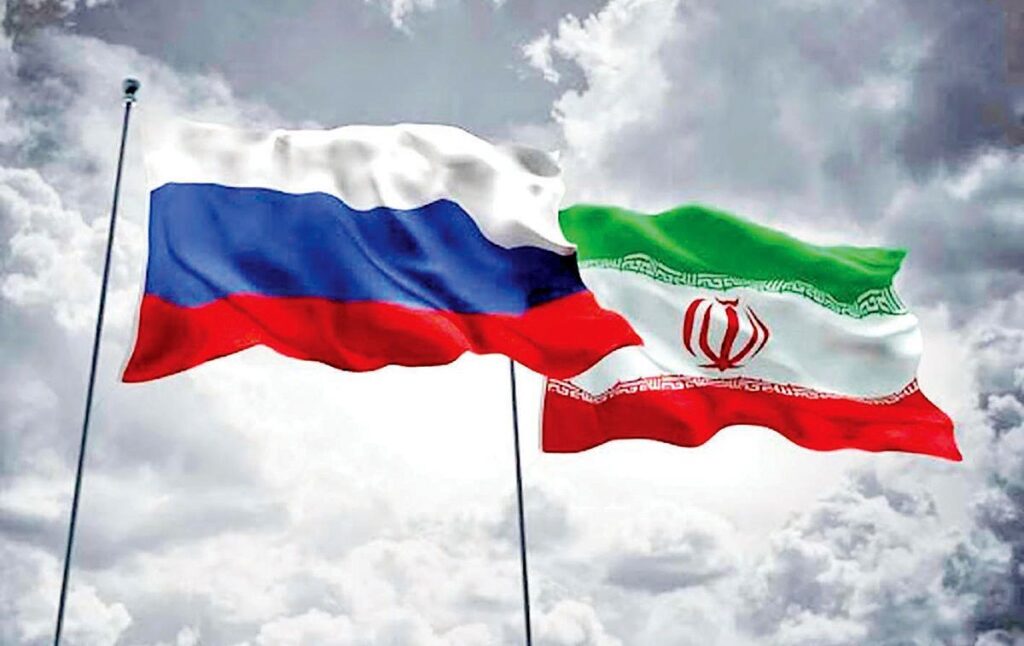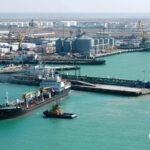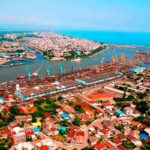North-South International Transport Corridor
The most important trade link between Asia and Europe
The North-South International Transport Corridor is one of the most important communication highways from West to South Asia, which was established on September 12, 2000 in Saint Petersburg by the three countries of Iran, Russia and India in order to promote transport cooperation.
This corridor connects the Indian Ocean and the Persian Gulf through Iran to the Caspian Sea, then through Russia / Saint Petersburg to Northern Europe. This passage is the most important trade link between Asia and Europe, which is 40% shorter in terms of distance and time and 30% more economical in terms of cost. The disconnection of western markets due to sanctions and the breakdown of logistics chains that connect Russia to Europe has increased the attractiveness of Iran as an important transportation hub. Russia and Iran have common strategic interests in Central Asia.
this corridor passes by the permanent commercial center “Iran-Russian Trade House/Fardad Expo” and this is one of the most important advantages of this center.
The North-South International Transport Corridor can revolutionize transport and trade. Learn about its Advantages and challenges
North-South Corridor
The North-South International Transport Corridor is a revitalized transport route connecting Northern Europe to South Asia. This corridor passes from St. Petersburg, Russia, through Iran and ends at Bandar Abbas in the Persian Gulf. This ambitious project aims to provide an efficient and cost-effective alternative to traditional land and sea routes for international trade between Europe and Asia. With a total length of more than 7,000 km, this modern infrastructure includes roads, railways, ports and other facilities necessary to transport cargo across Eurasia.
One of the most important advantages of the North-South International Transport Corridor is its potential to drastically reduce transit times from weeks or even months to days. It also cuts costs by bypassing busy seaports such as those in Singapore or Dubai. Overall, this transport corridor has become an essential tool for opening up new economic opportunities across Eurasia, while providing better connectivity between countries along the route.
The historical context of the North-South International Transport Corridor
The North-South Corridor, a project aimed at strengthening trade relations between Eurasian countries, is not a new idea. The concept of the corridor dates back to the early 1990s, when Russia and India proposed it to boost connectivity. However, due to various geopolitical factors, including US sanctions against Iran and Pakistan’s reluctance to hand over its territory for the implementation of this project, these plans could not be formed before. In 2002, an agreement was signed in St. Petersburg between Russia and Iran on cooperation in transport infrastructure projects, which included the development of the North-South International Transport Corridor (NSTC). Since then, several other countries have joined hands with Russia and Iran to implement the ambitious initiative, which aims to reduce transportation costs while promoting economic development across participating countries.
How the North-South International Transport Corridor is transforming transport in Eurasia
The North-South International Transport Corridor is a major infrastructure project that aims to connect Europe and Asia through a network of railways, roads and ports. This corridor is more than 7200 kilometers long, connecting Russia, Iran and India. It is expected to significantly reduce transportation costs and time for goods traveling between the two continents. It is also expected that this corridor will strengthen trade between countries and create new economic opportunities.
One of the key features of the North-South International Transport Corridor is its ability to bypass traditional shipping routes through the Suez Canal. This not only reduces transit time, but also reduces the risk of piracy in the Indian Ocean. This corridor is also designed to handle a wide range of cargo types, including perishable commodities and hazardous materials.
The North-South International Transport Corridor has seen significant progress in recent years, with new railway lines and ports built along its route. However, there are still challenges in terms of regulatory and financing issues. Despite these challenges, the corridor’s potential benefits make it an exciting development for Eurasia’s transportation infrastructure.
Key players and participation in the development of the North-South International Transport Corridor
The development of the North-South International Transport Corridor has been a joint effort between different countries and organizations. Russia, India and Iran have been the main driving forces of this project and Azerbaijan plays an important role in connecting this corridor to Europe. The International North-South Corridor Transit and Transportation Coordination Council (INSTC) has been established to oversee the development and implementation of the project.
Several partnerships have also been formed to support the corridor’s growth, including the Indo-Russia Joint Study Group on Transport Connectivity, which aims to increase connectivity between South Asia and Central Asia through the INSTC. The Federation of Freight Forwarding Associations in India has also signed an agreement with the International Road Transport Association of Iran to facilitate trade along the corridor.
Overall, these partnerships and collaborations are essential to ensure the success of the North-South International Transport Corridor. By working together, countries can overcome challenges such as infrastructure development and customs procedures, ultimately opening up new opportunities for trade and economic growth.

Creating new opportunities: trade between Europe and Asia through the North-South International Transport Corridor
The North-South International Shipping Corridor offers a new opportunity for trade between Europe and Asia by providing an alternative route to traditional maritime transport. Businesses on both continents can benefit from this corridor, with reduced transportation costs, shorter transit times, and increased security. Countries like Russia, Iran, Azerbaijan and India are developing their infrastructure along the corridor, recognizing its potential.
With a railway network of more than 7 thousand kilometers that connects the cities of St. Petersburg and Moscow, Russia to Iranian ports such as Bandar Abbas or Chabahar. With the signing of all international agreements, maritime traffic is expected to increase tenfold in just one year.
It also provides opportunities for landlocked countries such as Armenia to access seaports through this corridor, thereby increasing their global reach while opening new markets where prices They can be competitive due to lower shipping costs.
Sustainability, Efficiency and Innovation: Advantages of the North-South International Transport Corridor
Reducing Carbon: How the North-South International Transport Corridor Promotes Sustainability
The North-South International Transport Corridor not only offers faster and more efficient modes of transport, but also promotes sustainability by reducing carbon emissions. This route enables cargo to bypass longer traditional sea routes, resulting in lower carbon emissions due to shorter distances. In addition, the use of intermodal transportation has been implemented along the corridor, reducing dependence on individual modes of transportation such as trucks or ships. This helps reduce traffic congestion and air pollution. By promoting sustainable practices like this, the North-South International Transport Corridor contributes to a cleaner environment while efficiently delivering goods across Eurasia.
Facilitating Trade: The Efficiency Benefits of the North-South International Transport Corridor
The North-South International Transport Corridor offers significant benefits in terms of sustainability, efficiency and innovation. One of the key advantages is its ability to streamline trade between Europe and Asia, reducing shipping costs and times. By improving infrastructure and logistics, businesses can benefit from faster delivery times and reduced shipping times. This translates into increased competitiveness and profitability for companies along the corridor. In addition, the use of modern technologies such as electronic data interchange (EDI) and blockchain can increase the transparency and security of the supply chain. The North-South International Transport Corridor paves the way for a more efficient and sustainable future in Eurasian transport.
Innovations in Infrastructure: Technological Advances in the North-South International Transport Corridor
The North-South International Transport Corridor is not only a game-changer in terms of trade and commerce, but also a leader in technological advancements. Using modern infrastructure and new technologies, this corridor has been able to significantly reduce transportation costs and time. One of these innovations is the use of Electronic Data Interchange (EDI) systems, which enable seamless communication between different modes of transportation and customs authorities. In addition, the corridor has implemented GPS tracking systems to monitor the movement of cargo in real time, which ensures greater security and efficiency. These technological advances have made the North-South International Transport Corridor a sustainable and efficient option for businesses looking to expand their reach across Eurasia.
Enhancing Economic Growth: The Role of the North-South International Transport Corridor in Regional Development
The North-South International Transport Corridor not only paves the way for efficient and sustainable transport, but also plays an important role in boosting economic growth through regional development. This corridor connects Russia to Iran through Azerbaijan and provides a shorter route for trade between Asia and Europe. This leads to reduced transportation time and costs, as well as increased access to markets. In addition, infrastructure developments along the corridor will create job opportunities and attract investments that will promote industrialization and innovation. In summary, the efficiency of this transportation network has long-term positive effects on regional socio-economic growth and development.
Future prospects for expansion and growth along the North-South International Transport Corridor
The future prospects for expansion and growth along the North-South International Transport Corridor are promising. This corridor creates a direct connection between Asia and Europe, bypassing traditional routes that involve sea transport or long land journeys. As such, it has great potential to become a major route for trade between the two continents.
Several countries, including India and Afghanistan, have already expressed interest in joining the project. In addition, there are plans to extend the route from Russia to Finland as well as connect it to other major transport networks in Europe.
However, there are also challenges ahead that threaten this growth potential. These include political tensions between some countries along the route and competition over existing transport corridors.
Overall, if these challenges can be overcome through effective diplomacy and cooperation among the countries involved in the project, there will be room for significant expansion and growth of business opportunities through the North-South International Transport Corridor in the years to come.
Ultimately, the North-South International Transport Corridor opens up new opportunities and paves the way for a more interconnected world. With the historical context, key players and partnerships, trade opportunities between Europe and Asia, sustainability benefits and innovative solutions implemented along the corridor today, it is clear that this transport route has great potential to shape the future of Eurasia. However, as with any major infrastructure project of this size and scope, there are challenges ahead. By addressing these challenges through international cooperation and continued investment in infrastructure upgrades and technological advances, we can ensure that the North-South International Transport Corridor continues well into the future.



